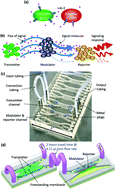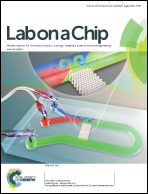Distal modulation of bacterial cell–cell signalling in a synthetic ecosystem using partitioned microfluidics†
Abstract
The human gut is over a meter in length, liquid residence times span several hours. Recapitulating the human gut microbiome “on chip” holds promise to revolutionize therapeutic strategies for a variety of diseases, as well as for maintaining homeostasis in healthy individuals. A more refined understanding of bacterial–bacterial and bacterial–epithelial cell signalling is envisioned and such a device is a key enabler. Indeed, significant advances in the study of bacterial cell–cell signalling have been reported, including at length and time scales of the cells and their responses. Few reports exist, however, where signalling events that span physiologically relevant time scales are monitored and coordinated. Here, we employ principles of biofabrication to assemble, in situ, cell communities that are (i) spatially adjacent within partitioned microchannels for studying near communication and (ii) distally connected within longitudinal microfluidic networks so as to mimic long distance signalling among intestinal flora. We observed native signalling processes of the bacterial quorum sensing autoinducer-2 (AI-2) system among and between these communities. Cells in an upstream device successfully self-reported their activities and also secreted autoinducers that were carried downstream to the assembled networks of bacteria that reported on their presence. Furthermore, active signal modulation of among distal populations was demonstrated in a “programmed” manner where “enhancer” and “reducer” communities were assembled adjacent to the test population or “reporter” cells. The modulator cells either amplified or attenuated the cell–cell signalling between the distal, already communicating cell populations. Modulation was quantified with a bioassay, and the reaction rates of signal production and consumption were further characterized using a first principles mathematical model. Simulated distribution profiles of signalling molecules in the cell–gel composites agreed well with the observed cellular responses. We believe this simple platform and the ease by which it is assembled can be applied to other cell–cell interaction studies among various species or kingdoms of cells within well-regulated microenvironments.


 Please wait while we load your content...
Please wait while we load your content...